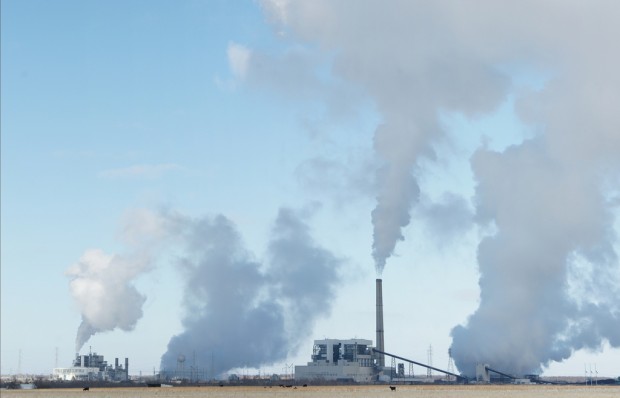
Public Service Co. of Oklahoma's coal and natural gas-fired Northeastern generating station in Oologah, Okla.
© Tom Nickell / Flickr


Public Service Co. of Oklahoma's coal and natural gas-fired Northeastern generating station in Oologah, Okla.
© Tom Nickell / Flickr

© Tom Nickell / Flickr
Public Service Co. of Oklahoma's coal and natural gas-fired Northeastern generating station in Oologah, Okla.
The Obama Administration recently announced stricter limits on ground-level ozone, a smog-causing pollutant closely monitored by environmentalists and the fossil fuel industry. The national rules are designed to address local air quality problems individual states can’t fix alone.
Goeller has his finger on the trigger. He checks the sensors, consults with meteorologists. And, if things look bad, he pushes the button.
“Well, it’s a pretty big button, but I’m involved in calling the ozone alerts,” says Goeller, an air quality specialist at the Oklahoma Department of Environmental Quality.
Oklahoma’s ozone alert “button” functions more like an email. When Goeller sounds the ground-level ozone alarm, cities and counties join him in a media blitz. Together, the government officials urge Oklahomans to put away the lawnmowers and park their cars. If it gets really bad, they tell kids, seniors and people with breathing problems to stay indoors.
But Oklahoma officials issued fewer ozone alerts in the last few years.
“It’s been a clean year,” Goeller says. “We’ve had a lot of precipitation, it’s been a little cooler than what we’ve seen the last few years. We have a nice breeze, and that tends to keep things clean.
Weather plays a large role in creating ozone, which is a big part of smog. Emissions from vehicle tailpipes, factories, refineries and power plants are big contributors, too. Those emissions plus heat and sunlight equal ground-level ozone. That’s why smog is usually worse in the summer months. In Oklahoma, ozone monitoring peaks from April through November.
Oklahoma’s air is getting cleaner, Goeller says. And not just because of the weather. He says federal ozone limits and air pollution rules are working.
The U.S. Environmental Protection Agency recently issued new stricter limits on ground-level ozone. The ozone rules arrive on the heels of the EPA’s controversial Clean Power Plan and proposed restrictions on methane emissions from the oil and gas industry.
Addressing Janet McCabe, the assistant administrator of the EPA’s Office of Air and Radiation, at a hearing of the Senate Environment and Public Works Committee, U.S. Senator Jim Inhofe of Oklahoma assailed the rules as part of President Barack Obama’s “air agenda.”
“These regulations would cost hundreds of billions of dollars, leaving stakeholders with an economic burden that will take generations to pay down,” Inhofe told the committee at the hearing in late September 2015.

Logan Layden / StateImpact Oklahoma
Meers area resident Bill Cunningham looks for haze over the Wichita Mountains from the top of Mt. Scott.
Inhofe, industry and state officials were worried the EPA would side with environmentalists and set the ground-level ozone standard to 65 parts per billion, which would likely mean all 77 counties in Oklahoma would be out of attainment.
“It is a very significant thing personally, to me, and the State of Oklahoma,” Inhofe said.
In the end, EPA Administrator Gina McCarthy settled in the middle. On October 1, the EPA set the new ground-level ozone standard at 70 parts per billion, a move seen by many as a win for industry groups.
With the new 70 parts per billion ground-level ozone standard — which is determined through a calculation of a specific monitoring site’s three-year average — most counties in Oklahoma should be in compliance, says the DEQ’s Goeller.
“We’ll have a couple sites that will be right on the borderline if things keep going the way they’ve gone the last couple of years,” he says.
Monitoring sites near Tulsa and Oklahoma City — where there’s a big concentration of cars and trucks — are the sites most likely to exceed the new EPA limits, Goeller says.
“We might flirt with being nonattainment with those two, but the rest of the sites in the state should be just fine.”
Smog is worsened by sunny, hot, still weather — which people can’t control. States like Oklahoma also can’t prevent ozone-causing precursor compounds from blowing in from neighboring sources — like Texas. Goeller says that’s why national ozone limits are important.
“We’re in the same boat that everyone across the nation is. We breathe the same air,” he says. “If we do our job here, everyone else will do their job, too.”
Goeller says air pollution is a problem that’s impossible to tackle on an individual state level. Over the decades, tougher, national air pollution rules have led to local success stories. When he first started monitoring air quality more than 20 years ago, Oklahoma governments regularly issued carbon monoxide alerts.
Not anymore. Goeller credits the federal government, which imposed strict emissions limits on cars and trucks
“That’s another air quality success story,” he says. “It just doesn’t happen anymore.”